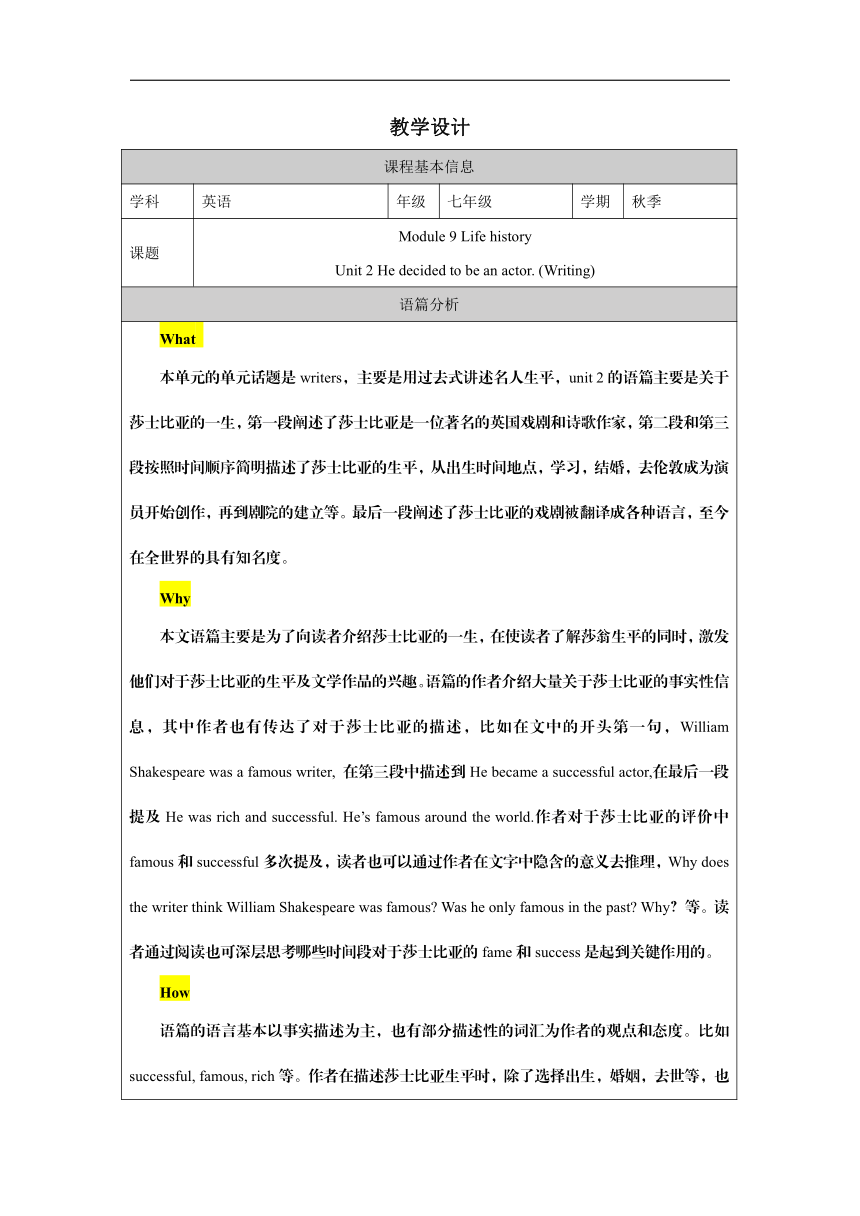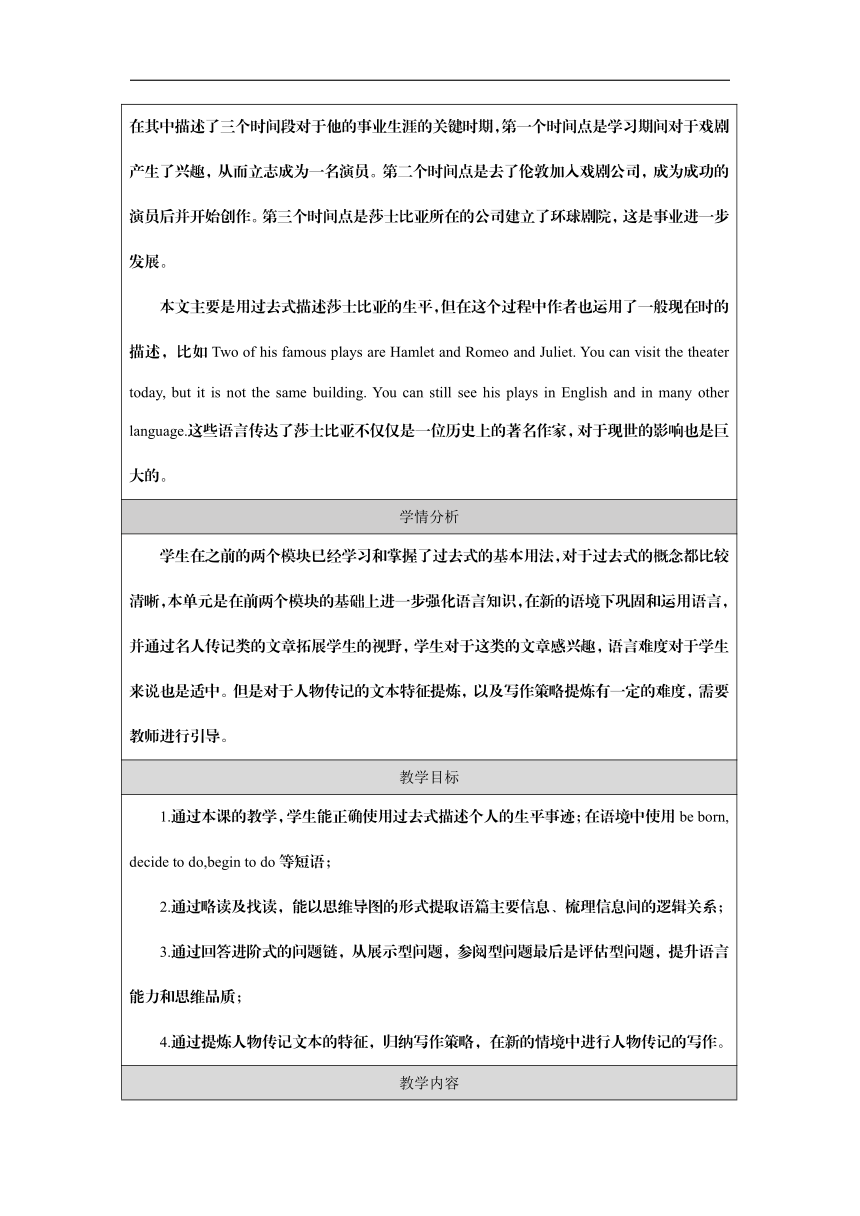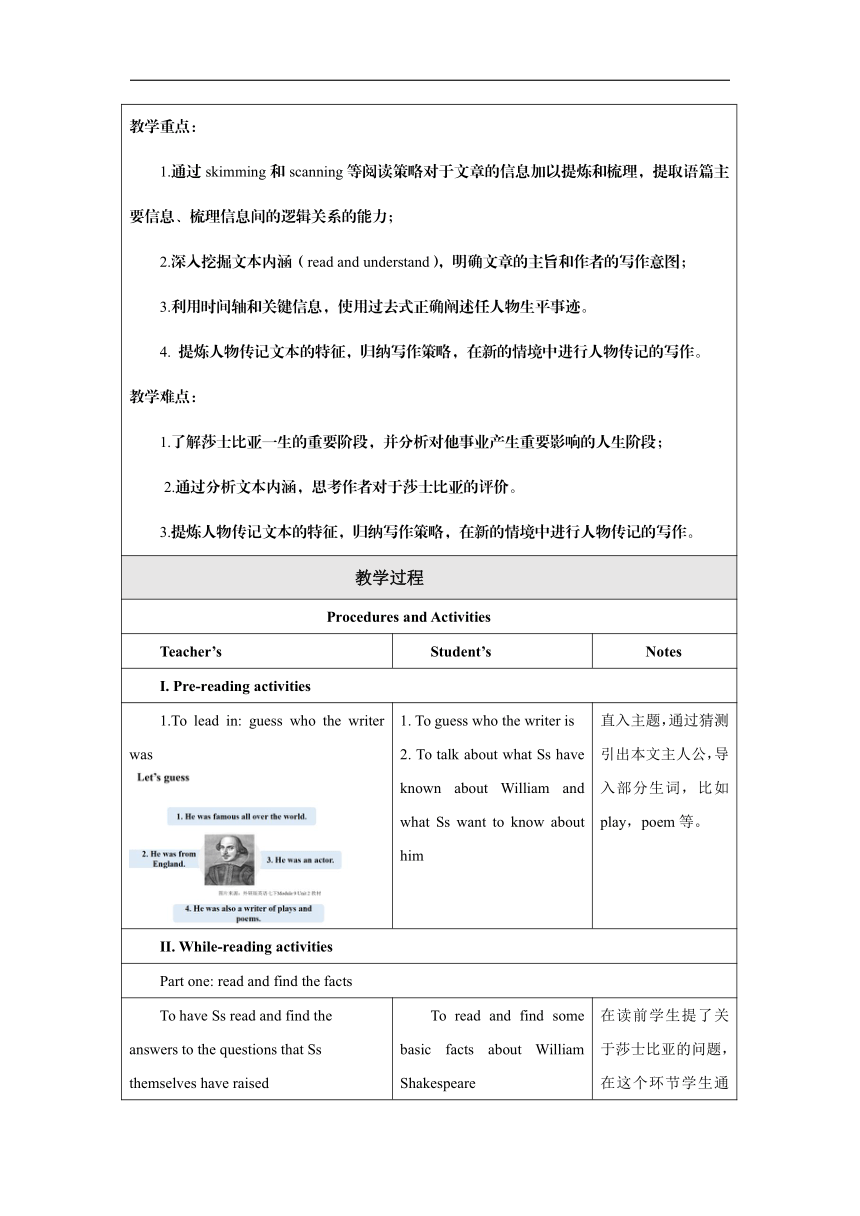外研版七年级下册Module 9 Life history Unit 2 He decided to be an actor Writing-教学设计(表格式)
文档属性
| 名称 | 外研版七年级下册Module 9 Life history Unit 2 He decided to be an actor Writing-教学设计(表格式) |

|
|
| 格式 | docx | ||
| 文件大小 | 825.4KB | ||
| 资源类型 | 教案 | ||
| 版本资源 | 外研版 | ||
| 科目 | 英语 | ||
| 更新时间 | 2024-04-07 22:23:25 | ||
图片预览



文档简介
教学设计
课程基本信息
学科 英语 年级 七年级 学期 秋季
课题 Module 9 Life history Unit 2 He decided to be an actor. (Writing)
语篇分析
What 本单元的单元话题是writers,主要是用过去式讲述名人生平,unit 2的语篇主要是关于莎士比亚的一生,第一段阐述了莎士比亚是一位著名的英国戏剧和诗歌作家,第二段和第三段按照时间顺序简明描述了莎士比亚的生平,从出生时间地点,学习,结婚,去伦敦成为演员开始创作,再到剧院的建立等。最后一段阐述了莎士比亚的戏剧被翻译成各种语言,至今在全世界的具有知名度。 Why 本文语篇主要是为了向读者介绍莎士比亚的一生,在使读者了解莎翁生平的同时,激发他们对于莎士比亚的生平及文学作品的兴趣。语篇的作者介绍大量关于莎士比亚的事实性信息,其中作者也有传达了对于莎士比亚的描述,比如在文中的开头第一句,William Shakespeare was a famous writer, 在第三段中描述到He became a successful actor,在最后一段提及He was rich and successful. He’s famous around the world.作者对于莎士比亚的评价中famous和successful多次提及,读者也可以通过作者在文字中隐含的意义去推理,Why does the writer think William Shakespeare was famous Was he only famous in the past Why?等。读者通过阅读也可深层思考哪些时间段对于莎士比亚的fame和success是起到关键作用的。 How 语篇的语言基本以事实描述为主,也有部分描述性的词汇为作者的观点和态度。比如successful, famous, rich等。作者在描述莎士比亚生平时,除了选择出生,婚姻,去世等,也在其中描述了三个时间段对于他的事业生涯的关键时期,第一个时间点是学习期间对于戏剧产生了兴趣,从而立志成为一名演员。第二个时间点是去了伦敦加入戏剧公司,成为成功的演员后并开始创作。第三个时间点是莎士比亚所在的公司建立了环球剧院,这是事业进一步发展。 本文主要是用过去式描述莎士比亚的生平,但在这个过程中作者也运用了一般现在时的描述,比如Two of his famous plays are Hamlet and Romeo and Juliet. You can visit the theater today, but it is not the same building. You can still see his plays in English and in many other language.这些语言传达了莎士比亚不仅仅是一位历史上的著名作家,对于现世的影响也是巨大的。
学情分析
学生在之前的两个模块已经学习和掌握了过去式的基本用法,对于过去式的概念都比较清晰,本单元是在前两个模块的基础上进一步强化语言知识,在新的语境下巩固和运用语言,并通过名人传记类的文章拓展学生的视野,学生对于这类的文章感兴趣,语言难度对于学生来说也是适中。但是对于人物传记的文本特征提炼,以及写作策略提炼有一定的难度,需要教师进行引导。
教学目标
1.通过本课的教学,学生能正确使用过去式描述个人的生平事迹;在语境中使用be born, decide to do,begin to do等短语; 2.通过略读及找读,能以思维导图的形式提取语篇主要信息、梳理信息间的逻辑关系; 3.通过回答进阶式的问题链,从展示型问题,参阅型问题最后是评估型问题,提升语言能力和思维品质; 4.通过提炼人物传记文本的特征,归纳写作策略,在新的情境中进行人物传记的写作。
教学内容
教学重点: 1.通过skimming和scanning等阅读策略对于文章的信息加以提炼和梳理,提取语篇主要信息、梳理信息间的逻辑关系的能力; 2.深入挖掘文本内涵(read and understand),明确文章的主旨和作者的写作意图; 3.利用时间轴和关键信息,使用过去式正确阐述任人物生平事迹。 4. 提炼人物传记文本的特征,归纳写作策略,在新的情境中进行人物传记的写作。 教学难点: 1.了解莎士比亚一生的重要阶段,并分析对他事业产生重要影响的人生阶段; 2.通过分析文本内涵,思考作者对于莎士比亚的评价。 3.提炼人物传记文本的特征,归纳写作策略,在新的情境中进行人物传记的写作。
教学过程
Procedures and Activities
Teacher’s Student’s Notes
I. Pre-reading activities
1.To lead in: guess who the writer was 1. To guess who the writer is 2. To talk about what Ss have known about William and what Ss want to know about him 直入主题,通过猜测引出本文主人公,导入部分生词,比如play,poem等。
II. While-reading activities
Part one: read and find the facts
To have Ss read and find the answers to the questions that Ss themselves have raised To have Ss read and find the facts about William Shakespeare To read and find some basic facts about William Shakespeare 在读前学生提了关于莎士比亚的问题,在这个环节学生通过阅读找到相关信息,并继续回答教师提出的相关信息,这一环节属于阅读找寻事实性信息。
Part two: Read and identify the structure and genre
To have Ss read and tell the genre of the text and know the feature of the biography To have Ss figure out the structure of the text To read and identify the structure of the text and its genre 学生通过阅读语篇明晰人物传记的文本特征以及文本结构特点。
Part three: Read and fill
To ask Ss to find the time and fill the information according to the time line To ask Ss to fill in the blanks To find the time period first and fill the information according to the timeline. 通过寻找莎士比亚生平的重要事件节点,以及完成他各个时间点的事迹,学生可以梳理莎士比亚生平。
Part four: Read and understand
1. To guide the student to think about the question “Which periods are important for Shakespeare's career Why 2. To present three periods and ask Ss why they are important for William Shakespeare 3. To guide students to further think about the question: 1) How successful was he Queen Elizabeth enjoyed his works very much. 4. To guide students to further think about the writer’s attitude towards William Shakespeare 1)What does the writer think of William Shakespeare 2)Did the writer think Shakespeare was only famous in the past Why? 1. To think about three important periods for Shakespeare and the reason 2. To read again and try to infer the meaning behind the text 3. To further think about the writer’s attitude towards William Shakespeare 1.学生通过阅读事实性信息后思考哪些时间节点对于莎士比亚事业的意义,比如年少时开始对表演产生兴趣,之后去伦敦开始表演并创作戏剧等。 2. 学生通过阅读文本信息并学会推理字里行间所隐含的意思。 3. 学生通过文本阅读后了解作者的对于莎士比亚的评价观点和态度,培养学生的读者意识和作者意识。
III. Post-reading activities
1.Think and share your opinions 1)What information about Shakespeare impressed you most 2)What do you want to know more about Shakespeare 1. To think about what information about Shakespeare impressed Ss most 2. To think about what information inspired them, and then read more and search more 学生阅读本文之后,对于莎士比亚有了进一步的了解,哪些信息对他们来说印象深刻,还有本文的哪些已有信息激发学生想要进一步了解关于莎士比亚具体而详细信息,引导学生思考并在课后做进一步的搜索,以便在下节课进行分享。
IV. Summarize
To have Ss summarize the writing strategies of how to write a biography To summarize the writing strategies of a biography 学生提炼和归纳人物传记的写作策略,为后续的写作输出提供策略的支撑。
V. Write and evaluate
1. Ask Ss to read a biography of Lu Xun and try to evaluate it according to checklist. To read a student’s version and try to evaluate it according to the checklist. 学生阅读一篇文本,然后利用评价表进行评价。
VI. Homework
Must do: 1. Summarize the text The Life of William Shakespeare. 2. Choose a person you admire and write about the life of him or her. Choose to do: 1. Shoot a video to introduce a person you admire. To summarize the text and choose to a person you admire to write a biography. To shoot a video to introduce a person you admire. 学生完成必做作业和选做作业,深入理解人物传记的语篇特征和写作技巧。
课后反思: 本节课阅读都是为写作服务的,通过阅读引导学生了解文本特征,提炼写作策略,并形成协作评价表促进写作的优化。读写过程中,时间比例的分配也是非常重要的,而且怎么设计阅读任务,帮助学生从语言,内容,结构三个层面去提炼也是值得我进一步思考的。
课程基本信息
学科 英语 年级 七年级 学期 秋季
课题 Module 9 Life history Unit 2 He decided to be an actor. (Writing)
语篇分析
What 本单元的单元话题是writers,主要是用过去式讲述名人生平,unit 2的语篇主要是关于莎士比亚的一生,第一段阐述了莎士比亚是一位著名的英国戏剧和诗歌作家,第二段和第三段按照时间顺序简明描述了莎士比亚的生平,从出生时间地点,学习,结婚,去伦敦成为演员开始创作,再到剧院的建立等。最后一段阐述了莎士比亚的戏剧被翻译成各种语言,至今在全世界的具有知名度。 Why 本文语篇主要是为了向读者介绍莎士比亚的一生,在使读者了解莎翁生平的同时,激发他们对于莎士比亚的生平及文学作品的兴趣。语篇的作者介绍大量关于莎士比亚的事实性信息,其中作者也有传达了对于莎士比亚的描述,比如在文中的开头第一句,William Shakespeare was a famous writer, 在第三段中描述到He became a successful actor,在最后一段提及He was rich and successful. He’s famous around the world.作者对于莎士比亚的评价中famous和successful多次提及,读者也可以通过作者在文字中隐含的意义去推理,Why does the writer think William Shakespeare was famous Was he only famous in the past Why?等。读者通过阅读也可深层思考哪些时间段对于莎士比亚的fame和success是起到关键作用的。 How 语篇的语言基本以事实描述为主,也有部分描述性的词汇为作者的观点和态度。比如successful, famous, rich等。作者在描述莎士比亚生平时,除了选择出生,婚姻,去世等,也在其中描述了三个时间段对于他的事业生涯的关键时期,第一个时间点是学习期间对于戏剧产生了兴趣,从而立志成为一名演员。第二个时间点是去了伦敦加入戏剧公司,成为成功的演员后并开始创作。第三个时间点是莎士比亚所在的公司建立了环球剧院,这是事业进一步发展。 本文主要是用过去式描述莎士比亚的生平,但在这个过程中作者也运用了一般现在时的描述,比如Two of his famous plays are Hamlet and Romeo and Juliet. You can visit the theater today, but it is not the same building. You can still see his plays in English and in many other language.这些语言传达了莎士比亚不仅仅是一位历史上的著名作家,对于现世的影响也是巨大的。
学情分析
学生在之前的两个模块已经学习和掌握了过去式的基本用法,对于过去式的概念都比较清晰,本单元是在前两个模块的基础上进一步强化语言知识,在新的语境下巩固和运用语言,并通过名人传记类的文章拓展学生的视野,学生对于这类的文章感兴趣,语言难度对于学生来说也是适中。但是对于人物传记的文本特征提炼,以及写作策略提炼有一定的难度,需要教师进行引导。
教学目标
1.通过本课的教学,学生能正确使用过去式描述个人的生平事迹;在语境中使用be born, decide to do,begin to do等短语; 2.通过略读及找读,能以思维导图的形式提取语篇主要信息、梳理信息间的逻辑关系; 3.通过回答进阶式的问题链,从展示型问题,参阅型问题最后是评估型问题,提升语言能力和思维品质; 4.通过提炼人物传记文本的特征,归纳写作策略,在新的情境中进行人物传记的写作。
教学内容
教学重点: 1.通过skimming和scanning等阅读策略对于文章的信息加以提炼和梳理,提取语篇主要信息、梳理信息间的逻辑关系的能力; 2.深入挖掘文本内涵(read and understand),明确文章的主旨和作者的写作意图; 3.利用时间轴和关键信息,使用过去式正确阐述任人物生平事迹。 4. 提炼人物传记文本的特征,归纳写作策略,在新的情境中进行人物传记的写作。 教学难点: 1.了解莎士比亚一生的重要阶段,并分析对他事业产生重要影响的人生阶段; 2.通过分析文本内涵,思考作者对于莎士比亚的评价。 3.提炼人物传记文本的特征,归纳写作策略,在新的情境中进行人物传记的写作。
教学过程
Procedures and Activities
Teacher’s Student’s Notes
I. Pre-reading activities
1.To lead in: guess who the writer was 1. To guess who the writer is 2. To talk about what Ss have known about William and what Ss want to know about him 直入主题,通过猜测引出本文主人公,导入部分生词,比如play,poem等。
II. While-reading activities
Part one: read and find the facts
To have Ss read and find the answers to the questions that Ss themselves have raised To have Ss read and find the facts about William Shakespeare To read and find some basic facts about William Shakespeare 在读前学生提了关于莎士比亚的问题,在这个环节学生通过阅读找到相关信息,并继续回答教师提出的相关信息,这一环节属于阅读找寻事实性信息。
Part two: Read and identify the structure and genre
To have Ss read and tell the genre of the text and know the feature of the biography To have Ss figure out the structure of the text To read and identify the structure of the text and its genre 学生通过阅读语篇明晰人物传记的文本特征以及文本结构特点。
Part three: Read and fill
To ask Ss to find the time and fill the information according to the time line To ask Ss to fill in the blanks To find the time period first and fill the information according to the timeline. 通过寻找莎士比亚生平的重要事件节点,以及完成他各个时间点的事迹,学生可以梳理莎士比亚生平。
Part four: Read and understand
1. To guide the student to think about the question “Which periods are important for Shakespeare's career Why 2. To present three periods and ask Ss why they are important for William Shakespeare 3. To guide students to further think about the question: 1) How successful was he Queen Elizabeth enjoyed his works very much. 4. To guide students to further think about the writer’s attitude towards William Shakespeare 1)What does the writer think of William Shakespeare 2)Did the writer think Shakespeare was only famous in the past Why? 1. To think about three important periods for Shakespeare and the reason 2. To read again and try to infer the meaning behind the text 3. To further think about the writer’s attitude towards William Shakespeare 1.学生通过阅读事实性信息后思考哪些时间节点对于莎士比亚事业的意义,比如年少时开始对表演产生兴趣,之后去伦敦开始表演并创作戏剧等。 2. 学生通过阅读文本信息并学会推理字里行间所隐含的意思。 3. 学生通过文本阅读后了解作者的对于莎士比亚的评价观点和态度,培养学生的读者意识和作者意识。
III. Post-reading activities
1.Think and share your opinions 1)What information about Shakespeare impressed you most 2)What do you want to know more about Shakespeare 1. To think about what information about Shakespeare impressed Ss most 2. To think about what information inspired them, and then read more and search more 学生阅读本文之后,对于莎士比亚有了进一步的了解,哪些信息对他们来说印象深刻,还有本文的哪些已有信息激发学生想要进一步了解关于莎士比亚具体而详细信息,引导学生思考并在课后做进一步的搜索,以便在下节课进行分享。
IV. Summarize
To have Ss summarize the writing strategies of how to write a biography To summarize the writing strategies of a biography 学生提炼和归纳人物传记的写作策略,为后续的写作输出提供策略的支撑。
V. Write and evaluate
1. Ask Ss to read a biography of Lu Xun and try to evaluate it according to checklist. To read a student’s version and try to evaluate it according to the checklist. 学生阅读一篇文本,然后利用评价表进行评价。
VI. Homework
Must do: 1. Summarize the text The Life of William Shakespeare. 2. Choose a person you admire and write about the life of him or her. Choose to do: 1. Shoot a video to introduce a person you admire. To summarize the text and choose to a person you admire to write a biography. To shoot a video to introduce a person you admire. 学生完成必做作业和选做作业,深入理解人物传记的语篇特征和写作技巧。
课后反思: 本节课阅读都是为写作服务的,通过阅读引导学生了解文本特征,提炼写作策略,并形成协作评价表促进写作的优化。读写过程中,时间比例的分配也是非常重要的,而且怎么设计阅读任务,帮助学生从语言,内容,结构三个层面去提炼也是值得我进一步思考的。
同课章节目录
- Module 1 Lost and found
- Unit 1 Whose bag is this?
- Unit 2 Are they yours?
- Unit 3 Language in use
- Module 2 What can you do ?
- Unit 1 I can play the piano
- Unit 2 I can run really fast
- Unit 3 Language in use
- Module 3 Making plans
- Unit 1 What are you going to do at the weekends?
- Unit 2 We're going to cheer the players.
- Unit 3 Language in use
- Module 4 Life in the future
- Unit 1 Everyone will study at home
- Unit 2 Every family will have a small plane.
- Unit 3 Language in use
- Module 5 Shopping
- Unit 1 What can I do for you?
- Unit 2 You can buy everything on the Internet
- Unit 3 Language in use
- Module 6 Around town
- Unit 1 Could you tell me how to get to the Nationa
- Unit 2 The London Eye is on your right.
- Unit 3 Language in use
- Revision module A
- Module 7 My past life
- Unit 1 I was born in a small village.
- Unit 2 I was born in Quincy.
- Unit 3 Language in use
- Module 8 Story time
- Unit 1 Once upon a time….
- Unit 2 Goldilocks hurried out of the house.
- Unit 3 Language in use
- Module 9 Life history
- Unit 1 He left school and began work at the age of
- Unit 2 He decided to be an actor.
- Unit 3 Language in use
- Module 10 A holiday journey
- Unit 1 What did you do?
- Unit 2 This morning we took a walk.
- Unit 3 Language in use
- Module 11 Body language
- Unit 1 They touch noses!
- Unit 2 Here are some ways to welcome them.
- Unit 3 Language in use
- Module 12 Western music
- Unit 1 It's so beautiful!
- Unit 2 Vienna is the centre of European classical
- Unit 3 Language in use
- Revision module B
